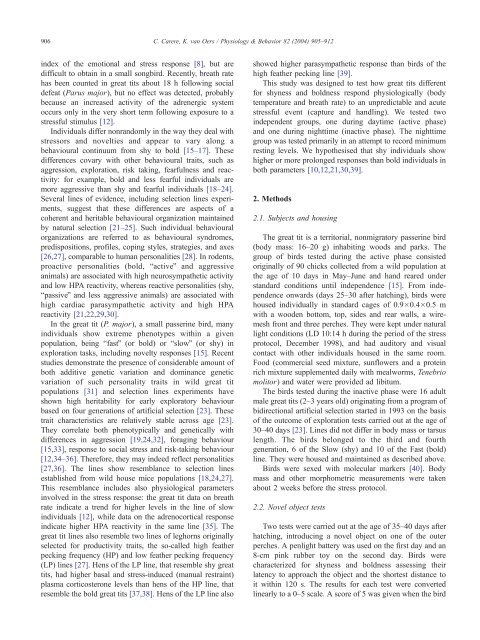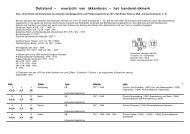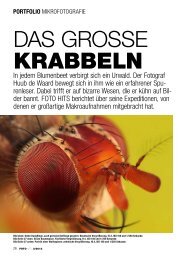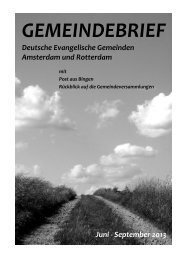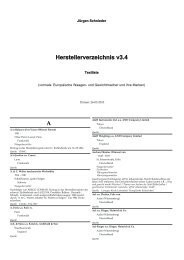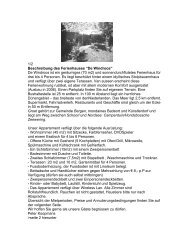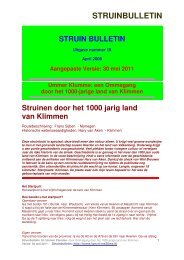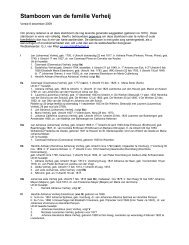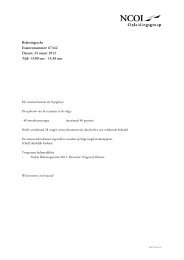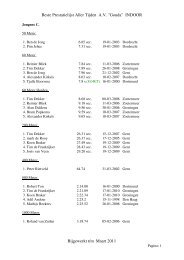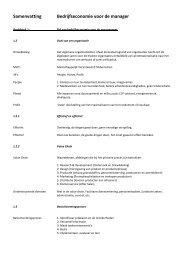body temperature and breath rate in response to handling stress
body temperature and breath rate in response to handling stress
body temperature and breath rate in response to handling stress
You also want an ePaper? Increase the reach of your titles
YUMPU automatically turns print PDFs into web optimized ePapers that Google loves.
906<br />
C. Carere, K. van Oers / Physiology & Behavior 82 (2004) 905–912<br />
<strong>in</strong>dex of the emotional <strong>and</strong> <strong>stress</strong> <strong>response</strong> [8], but are<br />
difficult <strong>to</strong> obta<strong>in</strong> <strong>in</strong> a small songbird. Recently, <strong>breath</strong> <strong>rate</strong><br />
has been counted <strong>in</strong> great tits about 18 h follow<strong>in</strong>g social<br />
defeat (Parus major), but no effect was detected, probably<br />
because an <strong>in</strong>creased activity of the adrenergic system<br />
occurs only <strong>in</strong> the very short term follow<strong>in</strong>g exposure <strong>to</strong> a<br />
<strong>stress</strong>ful stimulus [12].<br />
Individuals differ nonr<strong>and</strong>omly <strong>in</strong> the way they deal with<br />
<strong>stress</strong>ors <strong>and</strong> novelties <strong>and</strong> appear <strong>to</strong> vary along a<br />
behavioural cont<strong>in</strong>uum from shy <strong>to</strong> bold [15–17]. These<br />
differences covary with other behavioural traits, such as<br />
aggression, exploration, risk tak<strong>in</strong>g, fearfulness <strong>and</strong> reactivity:<br />
for example, bold <strong>and</strong> less fearful <strong>in</strong>dividuals are<br />
more aggressive than shy <strong>and</strong> fearful <strong>in</strong>dividuals [18–24].<br />
Several l<strong>in</strong>es of evidence, <strong>in</strong>clud<strong>in</strong>g selection l<strong>in</strong>es experiments,<br />
suggest that these differences are aspects of a<br />
coherent <strong>and</strong> heritable behavioural organization ma<strong>in</strong>ta<strong>in</strong>ed<br />
by natural selection [21–25]. Such <strong>in</strong>dividual behavioural<br />
organizations are referred <strong>to</strong> as behavioural syndromes,<br />
predispositions, profiles, cop<strong>in</strong>g styles, st<strong>rate</strong>gies, <strong>and</strong> axes<br />
[26,27], comparable <strong>to</strong> human personalities [28]. In rodents,<br />
proactive personalities (bold, bactiveQ <strong>and</strong> aggressive<br />
animals) are associated with high neurosympathetic activity<br />
<strong>and</strong> low HPA reactivity, whereas reactive personalities (shy,<br />
bpassiveQ <strong>and</strong> less aggressive animals) are associated with<br />
high cardiac parasympathetic activity <strong>and</strong> high HPA<br />
reactivity [21,22,29,30].<br />
In the great tit (P. major), a small passer<strong>in</strong>e bird, many<br />
<strong>in</strong>dividuals show extreme phenotypes with<strong>in</strong> a given<br />
population, be<strong>in</strong>g bfastQ (or bold) or bslowQ (or shy) <strong>in</strong><br />
exploration tasks, <strong>in</strong>clud<strong>in</strong>g novelty <strong>response</strong>s [15]. Recent<br />
studies demonst<strong>rate</strong> the presence of considerable amount of<br />
both additive genetic variation <strong>and</strong> dom<strong>in</strong>ance genetic<br />
variation of such personality traits <strong>in</strong> wild great tit<br />
populations [31] <strong>and</strong> selection l<strong>in</strong>es experiments have<br />
shown high heritability for early explora<strong>to</strong>ry behaviour<br />
based on four generations of artificial selection [23]. These<br />
trait characteristics are relatively stable across age [23].<br />
They correlate both phenotypically <strong>and</strong> genetically with<br />
differences <strong>in</strong> aggression [19,24,32], forag<strong>in</strong>g behaviour<br />
[15,33], <strong>response</strong> <strong>to</strong> social <strong>stress</strong> <strong>and</strong> risk-tak<strong>in</strong>g behaviour<br />
[12,34–36]. Therefore, they may <strong>in</strong>deed reflect personalities<br />
[27,36]. The l<strong>in</strong>es show resemblance <strong>to</strong> selection l<strong>in</strong>es<br />
established from wild house mice populations [18,24,27].<br />
This resemblance <strong>in</strong>cludes also physiological parameters<br />
<strong>in</strong>volved <strong>in</strong> the <strong>stress</strong> <strong>response</strong>: the great tit data on <strong>breath</strong><br />
<strong>rate</strong> <strong>in</strong>dicate a trend for higher levels <strong>in</strong> the l<strong>in</strong>e of slow<br />
<strong>in</strong>dividuals [12], while data on the adrenocortical <strong>response</strong><br />
<strong>in</strong>dicate higher HPA reactivity <strong>in</strong> the same l<strong>in</strong>e [35]. The<br />
great tit l<strong>in</strong>es also resemble two l<strong>in</strong>es of leghorns orig<strong>in</strong>ally<br />
selected for productivity traits, the so-called high feather<br />
peck<strong>in</strong>g frequency (HP) <strong>and</strong> low feather peck<strong>in</strong>g frequency<br />
(LP) l<strong>in</strong>es [27]. Hens of the LP l<strong>in</strong>e, that resemble shy great<br />
tits, had higher basal <strong>and</strong> <strong>stress</strong>-<strong>in</strong>duced (manual restra<strong>in</strong>t)<br />
plasma corticosterone levels than hens of the HP l<strong>in</strong>e, that<br />
resemble the bold great tits [37,38]. Hens of the LP l<strong>in</strong>e also<br />
showed higher parasympathetic <strong>response</strong> than birds of the<br />
high feather peck<strong>in</strong>g l<strong>in</strong>e [39].<br />
This study was designed <strong>to</strong> test how great tits different<br />
for shyness <strong>and</strong> boldness respond physiologically (<strong>body</strong><br />
<strong>temperature</strong> <strong>and</strong> <strong>breath</strong> <strong>rate</strong>) <strong>to</strong> an unpredictable <strong>and</strong> acute<br />
<strong>stress</strong>ful event (capture <strong>and</strong> h<strong>and</strong>l<strong>in</strong>g). We tested two<br />
<strong>in</strong>dependent groups, one dur<strong>in</strong>g daytime (active phase)<br />
<strong>and</strong> one dur<strong>in</strong>g nighttime (<strong>in</strong>active phase). The nighttime<br />
group was tested primarily <strong>in</strong> an attempt <strong>to</strong> record m<strong>in</strong>imum<br />
rest<strong>in</strong>g levels. We hypothesised that shy <strong>in</strong>dividuals show<br />
higher or more prolonged <strong>response</strong>s than bold <strong>in</strong>dividuals <strong>in</strong><br />
both parameters [10,12,21,30,39].<br />
2. Methods<br />
2.1. Subjects <strong>and</strong> hous<strong>in</strong>g<br />
The great tit is a terri<strong>to</strong>rial, nonmigra<strong>to</strong>ry passer<strong>in</strong>e bird<br />
(<strong>body</strong> mass: 16–20 g) <strong>in</strong>habit<strong>in</strong>g woods <strong>and</strong> parks. The<br />
group of birds tested dur<strong>in</strong>g the active phase consisted<br />
orig<strong>in</strong>ally of 90 chicks collected from a wild population at<br />
the age of 10 days <strong>in</strong> May–June <strong>and</strong> h<strong>and</strong> reared under<br />
st<strong>and</strong>ard conditions until <strong>in</strong>dependence [15]. From <strong>in</strong>dependence<br />
onwards (days 25–30 after hatch<strong>in</strong>g), birds were<br />
housed <strong>in</strong>dividually <strong>in</strong> st<strong>and</strong>ard cages of 0.90.40.5 m<br />
with a wooden bot<strong>to</strong>m, <strong>to</strong>p, sides <strong>and</strong> rear walls, a wiremesh<br />
front <strong>and</strong> three perches. They were kept under natural<br />
light conditions (LD 10:14 h dur<strong>in</strong>g the period of the <strong>stress</strong><br />
pro<strong>to</strong>col, December 1998), <strong>and</strong> had audi<strong>to</strong>ry <strong>and</strong> visual<br />
contact with other <strong>in</strong>dividuals housed <strong>in</strong> the same room.<br />
Food (commercial seed mixture, sunflowers <strong>and</strong> a prote<strong>in</strong><br />
rich mixture supplemented daily with mealworms, Tenebrio<br />
moli<strong>to</strong>r) <strong>and</strong> water were provided ad libitum.<br />
The birds tested dur<strong>in</strong>g the <strong>in</strong>active phase were 16 adult<br />
male great tits (2–3 years old) orig<strong>in</strong>at<strong>in</strong>g from a program of<br />
bidirectional artificial selection started <strong>in</strong> 1993 on the basis<br />
of the outcome of exploration tests carried out at the age of<br />
30–40 days [23]. L<strong>in</strong>es did not differ <strong>in</strong> <strong>body</strong> mass or tarsus<br />
length. The birds belonged <strong>to</strong> the third <strong>and</strong> fourth<br />
generation, 6 of the Slow (shy) <strong>and</strong> 10 of the Fast (bold)<br />
l<strong>in</strong>e. They were housed <strong>and</strong> ma<strong>in</strong>ta<strong>in</strong>ed as described above.<br />
Birds were sexed with molecular markers [40]. Body<br />
mass <strong>and</strong> other morphometric measurements were taken<br />
about 2 weeks before the <strong>stress</strong> pro<strong>to</strong>col.<br />
2.2. Novel object tests<br />
Two tests were carried out at the age of 35–40 days after<br />
hatch<strong>in</strong>g, <strong>in</strong>troduc<strong>in</strong>g a novel object on one of the outer<br />
perches. A penlight battery was used on the first day <strong>and</strong> an<br />
8-cm p<strong>in</strong>k rubber <strong>to</strong>y on the second day. Birds were<br />
characterized for shyness <strong>and</strong> boldness assess<strong>in</strong>g their<br />
latency <strong>to</strong> approach the object <strong>and</strong> the shortest distance <strong>to</strong><br />
it with<strong>in</strong> 120 s. The results for each test were converted<br />
l<strong>in</strong>early <strong>to</strong> a 0–5 scale. A score of 5 was given when the bird


